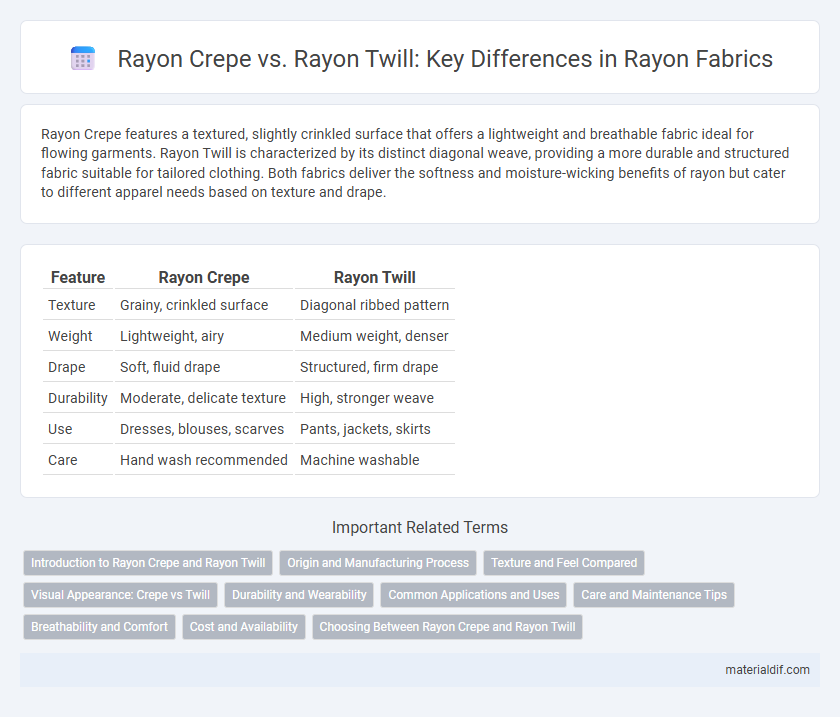Rayon Crepe features a textured, slightly crinkled surface that offers a lightweight and breathable fabric ideal for flowing garments. Rayon Twill is characterized by its distinct diagonal weave, providing a more durable and structured fabric suitable for tailored clothing. Both fabrics deliver the softness and moisture-wicking benefits of rayon but cater to different apparel needs based on texture and drape.
Table of Comparison
| Feature | Rayon Crepe | Rayon Twill |
|---|---|---|
| Texture | Grainy, crinkled surface | Diagonal ribbed pattern |
| Weight | Lightweight, airy | Medium weight, denser |
| Drape | Soft, fluid drape | Structured, firm drape |
| Durability | Moderate, delicate texture | High, stronger weave |
| Use | Dresses, blouses, scarves | Pants, jackets, skirts |
| Care | Hand wash recommended | Machine washable |
Introduction to Rayon Crepe and Rayon Twill
Rayon crepe features a distinctively textured, crinkled surface created through a special weaving technique that enhances fabric flexibility and breathability, ideal for elegant blouses and dresses. Rayon twill, characterized by its diagonal weave pattern, offers durability and a smooth drape, making it suitable for structured garments like trousers and blazers. Both fabrics maintain rayon's inherent softness and moisture-wicking properties while catering to different fashion and functional needs.
Origin and Manufacturing Process
Rayon Crepe and Rayon Twill originate from regenerated cellulose fibers derived primarily from wood pulp, with both fabrics undergoing chemical treatment in processes such as the viscose method. Rayon Crepe is created through a textured weaving technique that produces a crinkled, pebbled surface, while Rayon Twill is woven with a distinctive diagonal rib pattern, reflecting differences in their loom construction and finishing steps. Each manufacturing process influences the fabric's drape, texture, and durability, making Rayon Crepe softer and more fluid, and Rayon Twill stronger with enhanced resistance to wear.
Texture and Feel Compared
Rayon crepe features a distinctive grainy texture with a slightly crinkled surface, offering a soft, lightweight feel that drapes elegantly. In contrast, rayon twill has a smooth, diagonal weave pattern providing a more structured texture with moderate weight and durability. The crepe's textured appearance makes it ideal for flowy garments, while twill's firmness suits tailored clothing requiring shape retention.
Visual Appearance: Crepe vs Twill
Rayon Crepe showcases a textured, slightly crinkled surface with a matte finish, offering a soft drape and elegant visual depth. Rayon Twill features a distinct diagonal weave pattern, creating a smoother, more structured appearance with subtle sheen and enhanced durability. Both fabrics provide versatile aesthetics, but Crepe leans towards a fluid, delicate look while Twill emphasizes definition and resilience.
Durability and Wearability
Rayon Twill offers superior durability compared to Rayon Crepe due to its tightly woven diagonal pattern, which enhances fabric strength and resistance to wear. Rayon Crepe, while softer and more lightweight, tends to be less durable and more prone to snags and pilling over extended use. For long-lasting apparel and frequent wear, Rayon Twill provides better longevity and maintains its structural integrity under regular stress.
Common Applications and Uses
Rayon Crepe is favored for its lightweight, textured surface, making it ideal for elegant dresses, blouses, and scarves that require a soft drape and fluid movement. Rayon Twill, characterized by its diagonal weave and durability, is commonly used in tailored garments such as trousers, jackets, and uniforms that demand structure and strength. Both fabrics provide breathability and comfort, but Rayon Crepe suits flowy, delicate designs while Rayon Twill supports more robust, everyday wear.
Care and Maintenance Tips
Rayon crepe requires gentle hand washing in cold water to preserve its delicate texture and prevent shrinking, while rayon twill benefits from machine washing on a gentle cycle with cold water to maintain its smooth finish and durability. Both fabrics should be air-dried away from direct sunlight to avoid fading and fabric damage. Iron rayon crepe on a low setting with a pressing cloth to prevent shine, whereas rayon twill can tolerate medium heat ironing for a crisp appearance without compromising the fabric integrity.
Breathability and Comfort
Rayon Crepe offers superior breathability due to its lightweight and slightly textured weave, allowing better air circulation and moisture wicking, which enhances overall comfort in warm climates. Rayon Twill has a denser weave with diagonal ribs, providing more durability but less breathability, making it better suited for structured garments that require a firmer texture. For optimal comfort in hot weather, Rayon Crepe is preferred, while Rayon Twill balances comfort with sturdiness for transitional seasons.
Cost and Availability
Rayon crepe typically costs more than rayon twill due to its intricate texture and slightly complex manufacturing process. Rayon twill is more widely available in the market because of its simpler weave and versatility in various apparel and home textile applications. Budget-conscious buyers often prefer rayon twill for its affordability and ease of sourcing without sacrificing quality.
Choosing Between Rayon Crepe and Rayon Twill
Rayon crepe offers a textured, crinkled surface ideal for draping and flowy silhouettes, while rayon twill features a distinct diagonal weave that provides durability and a smooth finish suitable for structured garments. Choosing between rayon crepe and rayon twill depends on the desired garment appearance and function, with crepe favored for elegance and softness, and twill preferred for its strength and wrinkle resistance. Fabric weight and pattern intricacy also influence selection, as heavier twills work well for tailored clothing whereas lighter crepes enhance breathability and comfort.
Rayon Crepe vs Rayon Twill Infographic

 materialdif.com
materialdif.com